
Rosa Bonheur was a French artist known best as a painter of animals (animalière). She also made sculptures in a realist style. Her paintings include Ploughing in the Nivernais, first exhibited at the Paris Salon of 1848, and now in the Musée d'Orsay in Paris, and The Horse Fair, which was exhibited at the Salon of 1853 and is now in the Metropolitan Museum of Art in New York City. Bonheur was widely considered to be the most famous female painter of the nineteenth century.

Thomas Cowperthwait Eakins was an American realist painter, photographer, sculptor, and fine arts educator. He is widely acknowledged to be one of the most important American artists.

Pierre Auguste Cot was a French painter of the Academic Classicism school.

Madame X or Portrait of Madame X is a portrait painting by John Singer Sargent of a young socialite, Virginie Amélie Avegno Gautreau, wife of the French banker Pierre Gautreau. Madame X was painted not as a commission, but at the request of Sargent. It is a study in opposition. Sargent shows a woman posing in a black satin dress with jeweled straps, a dress that reveals and hides at the same time. The portrait is characterized by the pale flesh tone of the subject contrasted against a dark-colored dress and background.
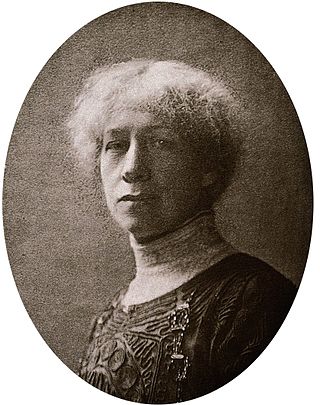
Anna Elizabeth Klumpke was an American portrait and genre painter born in San Francisco, California, United States. She is perhaps best known for her portraits of famous women including Elizabeth Cady Stanton (1889) and Rosa Bonheur (1898).
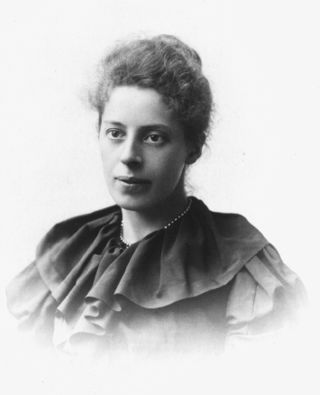
Dorothea Klumpke Roberts was an American astronomer. She was the Director of the Bureau of Measurements at the Paris Observatory and was made a Chevalier de la Légion d'Honneur, or a Knight of the National Order of the Legion of Honor.

Young Girl Reading, or The Reader, is an 18th-century oil painting by Jean-Honoré Fragonard. It depicts an unidentified girl seated in profile, wearing a lemon yellow dress with white ruff collar and cuffs and purple ribbons, and reading from a small book held in her right hand. The painting is in the National Gallery of Art in Washington, DC.

The Horse Fair is an oil-on-canvas painting by French artist Rosa Bonheur, begun in 1852 and first exhibited at the Paris Salon in 1853. The artist added some finishing touches in 1855. The large work measures 96.25 in × 199.5 in.
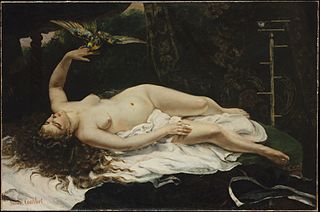
La Femme au perroquet is an oil painting on canvas by French artist Gustave Courbet. It was the first nude by the artist to be accepted by the Paris Salon in 1866 after a previous entry in 1864 was rejected as indecent. It is in the collection of the Metropolitan Museum of Art in New York city.
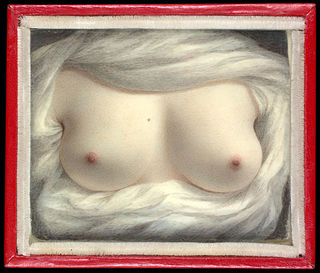
Beauty Revealed is an 1828 self-portrait by the American artist Sarah Goodridge, a watercolor portrait miniature on a piece of ivory. Depicting only the artist's bared breasts surrounded by white cloth, the 6.7-by-8-centimeter painting, originally backed with paper, is now in a modern frame. Goodridge, aged forty when she completed the miniature, depicts breasts that appear imbued with a "balance, paleness, and buoyancy" by the harmony of light, color, and balance. The surrounding cloth draws the viewer to focus on them, leading to the body being "erased".

The roles of women in France have changed throughout history. In 1944, French women obtained women's suffrage. As in other Western countries, the role of women underwent many social and legal changes in the 1960s and 1970s. French feminism, which has its origins in the French Revolution, has been quite influential in the 20th century with regard to abstract ideology, especially through the writings of Simone de Beauvoir. In addition the article covers scholarly work on topics in history, education, reproductive rights, families, feminism, domestic violence, religion and art.

Cha-U-Kao was a French entertainer who performed at the Moulin Rouge and the Nouveau Cirque in the 1890s. Her stage name was also the name of a boisterous popular dance, similar to the can-can, which came from the French words "chahut", meaning "noise" and "chaos". She was depicted in a series of paintings by Henri de Toulouse-Lautrec. Cha-U-Kao soon became one of his favorite models. The artist was fascinated by this woman who dared to choose the classic male profession of clowning and was not afraid to openly declare that she was a lesbian.
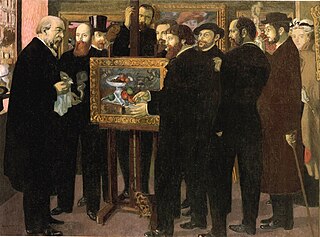
Homage to Cézanne is a painting in oil on canvas by the French artist Maurice Denis dating from 1900. It depicts a number of key figures from the once secret brotherhood of Les Nabis. The painting is a retrospective; by 1900 the group was breaking up as its members matured.

Ploughing in the Nivernais, also known as Oxen ploughing in Nevers or Plowing in Nivernais, is an 1849 painting by French artist Rosa Bonheur. It depicts two teams of oxen ploughing the land, and expresses deep commitment to the land; it may have been inspired by the opening scene of George Sand's 1846 novel La Mare au Diable. Commissioned by the government and winner of a First Medal at the Salon in 1849, today it is held in the Musée d'Orsay in Paris.

Self-Portrait with Bandaged Ear is an 1889 self-portrait by Dutch Post-Impressionist artist Vincent van Gogh. The painting is in the collection of the Courtauld Institute of Art and on display in the Gallery at Somerset House. The painting includes inspiration from Japanese Woodblock printing.

The Château de By, otherwise the Musée de l'atelier Rosa Bonheur is a museum run by a private owner, Katherine Brault, in the French department of Seine-et-Marne, on the edge of the Fontainebleau Forest. It is named after the former town of By, near Thomery. It was closed for refurbishment in 2016 but has since reopened by the Brault family in 2018.

Woman with Parakeet is a painting by Pierre-Auguste Renoir created in 1871. It is in the holdings of the Solomon R. Guggenheim Museum in New York as part of the Thannhauser Collection. The painting portrays model Lise Tréhot, who posed for Renoir in over twenty paintings during the years 1866 to 1872.

Mother and Child (The Oval Mirror) is an oil-on-canvas painting by the American Impressionist artist Mary Cassatt. The painting depicts a mother and her child in front of a mirror. The painting provides a glimpse of the domestic life of a mother and her child, evoking religious iconography from the Italian Renaissance. However, portrayals of a mother and her child are common in Cassatt's work, so it is possible that this similarity is coincidental rather than intentional.
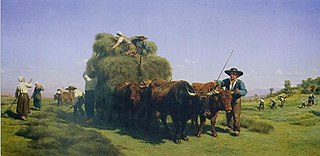
Haymaking in the Auvergne is an 1855 oil painting by French artist Rosa Bonheur. It measures 215 cm × 422 cm.
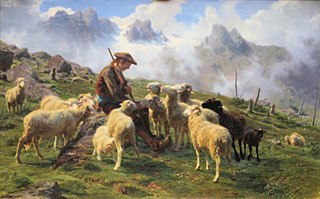
Pyrenean Shepherd Offering Salt to his Sheep is an oil-on-canvas painting by French artist Rosa Bonheur, executed in 1864. It his held at the Musée Condé, in Chantilly. The painting was commissioned by Henri d'Orléans, Duke of Aumale.




















